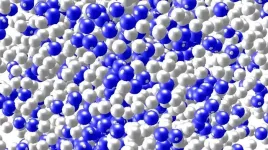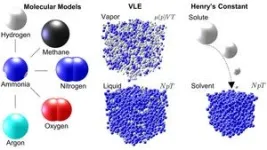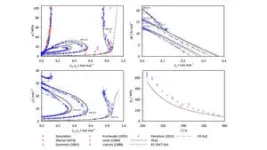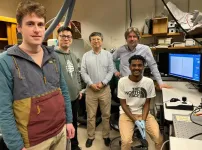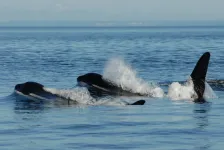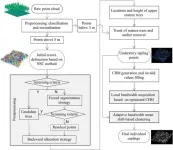(Press-News.org) Ammonia (NH3) is an important molecule with many applications. The end product of the famed Haber–Bosch process, it is commonly synthesized to capture nitrogen for fertilizers, and is used for refrigeration, in cleaning products, and in the production of pharmaceuticals. Recently, this modest molecule has also attracted interest as a potential resource for addressing one of today’s most pressing challenges — the need for reliable and abundant renewable fuels.
Ammonia is stable and safe to handle, is combustible, and contains the largest fraction of hydrogen of any molecule except for pure hydrogen itself. These factors promise to make it a feasible alternative to the carbon-based energy carriers that are driving climate change. Research has begun to explore how ammonia could be used to directly power engines, gas turbines, and hydrogen fuel cells, for example. It is also believed that ammonia could be used to store energy for times when other renewables like wind and solar power cannot meet demand.
Much is known about ammonia, but this interest in using it as a fuel has initiated a search for new ammonia technologies. This has, in turn, led to an increased need among chemical engineers for accurate data describing ammonia’s fundamental thermodynamic properties. Such properties include a wide variety of measurable traits such as phase equilibria, density, or heat capacity, for example, that characterize physical systems and determine how chemical processes work. In the case of ammonia, engineers would also like to have better knowledge of how such properties change when mixing ammonia with other molecules. Such knowledge could help them to optimize processes and operating conditions.
Dr. Jadran Vrabec, currently the director of the Institute for Process Sciences at the Technical University of Berlin, has spent much of his career using high-performance computing (HPC) to investigate thermodynamic properties at the molecular level. “Thermodynamic properties are 100% determined by molecular interactions,” he explains. “And because these interactions happen so fast and at such a small scale, it is only possible to study them by performing large simulations using supercomputers.”
In a recent paper published in the Journal of Chemical & Engineering Data, he and coauthor Erich Mace of the TU Berlin report on the results of simulations focused on the thermodynamic properties of mixtures containing ammonia. Produced using the Hawk supercomputer at the High-Performance Computing Center Stuttgart (HLRS), their results add valuable data that could support the development of new applications of ammonia. The results could also help to assess the accuracy of other existing data, ensuring that engineers have the best available information for working with the substance.
Large-scale simulations provide unique insights into thermodynamic properties
Vrabec is a longtime user of HLRS supercomputing resources for molecular dynamics and Monte Carlo simulations. His approach relies on concepts of thermodynamics that were first articulated by Ludwig Boltzmann in the 19th century but only became practical to apply in the 1950s with the arrival of the first computers. Since then, the field has advanced in parallel with the development of larger and faster supercomputers, to the point that Vrabec’s simulations now track the individual motions and interactions of billions or even trillions of molecules simultaneously. Using software his lab developed to selectively capture data of interest, he can then study the molecules’ thermodynamic properties.
Vrabec uses two simulation codes called ms2 and ls1, which he has developed and optimized over the course of a long and fruitful collaboration with HLRS staff members Martin Bernreuther and Christoph Niethammer. In 2019 the team even set a world record for the largest molecular system ever simulated using molecular dynamics methods. Using ls1, they efficiently scaled their code to a system of 21 trillion atoms in which every individual molecule and its interactions with other molecules could be tracked.
In the recent work on ammonia, Mace and Vrabec performed molecular dynamics and Monte Carlo simulations using ms2 to investigate five commonly used mixtures involving ammonia in chemical engineering processes: argon–ammonia, methane–ammonia, hydrogen–ammonia, nitrogen–ammonia, and oxygen–ammonia. For each mixture the simulations generated data describing the vapor-liquid equilibrium (VLE) — a measurement of the distribution of molecules in a system across the vapor or liquid phases — for a wide range of temperatures and pressures. In their paper Mace and Vrabec point out that VLE data is often used in developing equations of state for industrial fluids; that is, the data can be used to predict the state of matter under different physical conditions due to changes in temperature, pressure, volume, or composition. Such information is essential for determining optimal mixtures and working conditions in industrial applications.
Vrabec’s molecular simulations are particularly valuable because they can be used to investigate a much wider range of scales than is possible using experimental approaches. “In our simulations, we provided measurements of thermodynamic properties even up to pressures of 50 megapascals. This is 500 times our ambient air pressure,” Vrabec remarks. “Although data for ammonia mixtures have been gathered for more than a century, the data coverage is surprisingly narrow. The reason is that the effort to measure it experimentally is prohibitively huge. It would require expensive special equipment that would be dangerous to operate. In computer simulations, we can get results safely and relatively inexpensively.” His methods also provide a comparable level of accuracy to that of experimental approaches in ranges where experimental data is available.
Better data for ammonia research
When Mace and Vrabec analyzed their simulation data, they showed that although ammonia is a component in all five systems they studied, the resulting graphs of VLE values look dramatically different for different molecular mixtures. According to Vrabec, “The phase behavior of different mixtures is strongly determined by the interactions among the molecules in the system. You need to understand these properties if you are interested in working with ammonia mixtures.”
The paper and its supplementary data offer more than 400 new data points for each mixture they studied. Using Hawk, they were able to produce the results of each mixture within just a few days of computing time. The results will be of particular value for extreme, difficult-to-study conditions for which little data is available, and could help engineers to identify sweet spots where conditions would be optimal for efficient ammonia processing.
The study included both new simulation data and previously published data from the scientific literature, enabling Mace and Vrabec to compare their results with other existing datasets of VLE values. In most situations, their results corresponded closely with those of previous studies. In some cases, however, they identified significant divergences between their results and other research groups’ experimentally generated measurements and predictions. The authors attribute these discrepancies to limitations or inaccuracies in the corresponding experimental methods. They also suggest that specific experimental data sources should be used with caution in future research or chemical engineering applications.
Vrabec says that in recent work, he has focused primarily on simulating thermodynamic properties of molecular systems, generally at the sub-micrometer scale. Despite the many orders of magnitude that lie between this scale and the level of observable processes, accurate methods exist for translating these molecular-level insights into useful real-world predictions. As supercomputers grow larger, however, he anticipates that it might also become possible to simulate not just properties but also thermodynamic processes using boundary conditions that are close to real-world applications. Increased HPC performance could produce more accurate results about dynamic phenomena with a better signal-to-noise ratio.
In the meantime, though, his team’s results demonstrate the value of molecular dynamics and Monte Carlo simulation using high-performance computing, and will provide new understanding of phase behavior that engineers can use to develop new ammonia-based technologies.
END
Molecular simulations of ammonia mixtures support search for renewable fuels
Using HLRS’s Hawk supercomputer, scientists at the TU Berlin generate valuable thermodynamic data for chemical engineering research
2024-03-13
ELSE PRESS RELEASES FROM THIS DATE:
First recognition of self in the mirror is spurred by touch
2024-03-13
Most babies begin recognizing themselves in mirrors when they are about a year and half old. This kind of self-recognition is an important developmental milestone, and now scientists at The University of Texas at Austin have discovered a key driver for it: experiences of touch.
Their new study found babies who were prompted to touch their own faces developed self-recognition earlier than those who did not. The research was published this month in the journal Current Biology.
“This suggests that babies pulling ...
Dartmouth engineering team discovers new high-performance solar cell material
2024-03-13
A Dartmouth Engineering-led study published in Joule reported the discovery of an entirely new high-performance material for solar absorbers—the central part of a solar cell that turns light into electricity—that is stable and earth-abundant. The researchers used a unique high-throughput computational screening method to accelerate the discovery process and were able to quickly evaluate approximately 40,000 known candidate materials.
"This is the first example in the field of photovoltaics where a new material has been found through this type ...
Advancing toward wearable stretchable electronics
2024-03-13
Small wearable or implantable electronics could help monitor our health, diagnose diseases, and provide opportunities for improved, autonomous treatments. But to do this without aggravating or damaging the cells around them, these electronics will need to not only bend and stretch with our tissues as they move, but also be soft enough that they will not scratch and damage tissues.
Researchers at Stanford have been working on skin-like, stretchable electronic devices for over a decade. In a paper published ...
Menopause explains why some female whales live so long
2024-03-13
Females of some whale species have evolved to live drastically longer lives so they can care for their families, new research shows.
The study focussed on five whale species that – along with humans – are the only mammals known to go through menopause.
The findings show that females of these whale species that experience menopause live around 40 years longer than other female whales of a similar size.
By living longer without extending their “reproductive lifespan” (the years in which they breed), these ...
Supply chain disruptions will further exacerbate economic losses from climate change
2024-03-13
UCL Press Release
Under embargo until Wednesday 13 March 2024, 16:00 UK time / 12:00 US Eastern time
Global GDP loss from climate change will increase exponentially the warmer the planet gets when its cascading impact on global supply chains is factored in, finds a new study led by UCL researchers.
The study, published in Nature, is the first to chart “indirect economic losses” from climate change on global supply chains that will affect regions that would have been less affected by projected warming temperatures.
These previously unquantified disruptions in supply chains will further exacerbate projected economic losses due ...
The SNF Institute for Global Infectious Disease Research announces new advisory board
2024-03-13
From identifying the influenza virus that caused the pandemic of 1918 to developing vaccines against pneumococcal pneumonia and bacterial meningitis in the 1970s, combating infectious disease has a rich history at Rockefeller. That tradition continues as the Stavros Niarchos Foundation Institute for Global Infectious Disease Research at Rockefeller University (SNFiRU) caps a successful first year with the establishment of a new advisory board.
This international advisory board was created in part to give guidance on how to best use ...
How the brain wakes us from daydreams
2024-03-13
When we daydream, we must be able to snap back to attention at a moment’s notice. Researchers at Boston Children’s Hospital uncovered how our brains can do things like react to a question when we’re daydreaming: firing activity in part of the brain called the dentate gyrus keeps us focused on what’s happening in our environment. And the team found that the same neural activity also helps with forming memories. The findings were published in Nature on March 13, 2024.
“We have found a brain mechanism for breaking up periods of mind wandering and realigning the ‘cognitive ...
Revolutionizing forest management: unveiling understory saplings with advanced airborne LiDAR technology
2024-03-13
The regeneration of forest saplings is pivotal for maintaining biodiversity and ecosystem productivity, necessitating innovative management techniques for continuous forest coverage. Traditional 2-dimensional remote sensing struggles to accurately capture the complex, understory sapling dynamics. To address this, researchers are exploring the use of aerial laser scanning (ALS) for its potential in providing detailed 3-dimensional insights. However, despite progress in using ALS data to estimate tree metrics, accurately identifying and quantifying the phenotypic ...
High resolution imagery advances the ability to monitor decadal changes in emperor penguin populations
2024-03-13
Woods Hole, Mass. (March 13, 2024) - Emperor penguin populations have been exceedingly difficult to monitor because of their remote locations, and because individuals form breeding colonies on seasonal sea ice fastened to land (known as fast ice) during the dark and cold Antarctic winter.
Now, new research that incorporates very high resolution (VHR) satellite imagery with field-based validation surveys and long-term data has provided the first multi-year time series that documents emperor penguin global population trends.
Researchers ...
Gilbert H. L. Tang appointed Editor-in-Chief of JACC: Case Reports
2024-03-13
Renowned cardiovascular surgeon Gilbert H. L. Tang has been named Editor-in-Chief of JACC: Case Reports, bringing a wealth of experience and expertise to the helm of one of the top cardiovascular journals published by the American College of Cardiology.
“I am both honored and humbled to be a cardiac surgeon among the Editor-in-Chiefs in the JACC family of journals,” Tang said. “It is going to be an exciting time for JACC: Case Reports to build on a team of multidisciplinary cardiovascular practitioners with diverse backgrounds and experiences, and at different stages of their professional careers, to enhance the journal’s academic and educational impact globally.”
Tang ...
LAST 30 PRESS RELEASES:
Numbers in our sights affect how we perceive space
SIMJ announces global collaborative book project in commemoration of its 75th anniversary
Air pollution exposure and birth weight
Obstructive sleep apnea risk and mental health conditions among older adults
How talking slows eye movements behind the wheel
The Ceramic Society of Japan’s Oxoate Ceramics Research Association launches new international book project
Heart-brain connection: international study reveals the role of the vagus nerve in keeping the heart young
Researchers identify Rb1 as a predictive biomarker for a new therapeutic strategy in some breast cancers
Survey reveals ethical gaps slowing AI adoption in pediatric surgery
Stimulant ADHD medications work differently than thought
AI overestimates how smart people are, according to HSE economists
HSE researchers create genome-wide map of quadruplexes
Scientists boost cell "powerhouses" to burn more calories
Automatic label checking: The missing step in making reliable medical AI
Low daily alcohol intake linked to 50% heightened mouth cancer risk in India
American Meteorological Society announces Rick Spinrad as 2026 President-Elect
Biomass-based carbon capture spotlighted in newly released global climate webinar recording
Illuminating invisible nano pollutants: advanced bioimaging tracks the full journey of emerging nanoscale contaminants in living systems
How does age affect recovery from spinal cord injury?
Novel AI tool offers prognosis for patients with head and neck cancer
Fathers’ microplastic exposure tied to their children’s metabolic problems
Research validates laboratory model for studying high-grade serous ovarian cancer
SIR 2026 delivers transformative breakthroughs in minimally invasive medicine to improve patient care
Stem Cell Reports most downloaded papers of 2025 highlight the breadth and impact of stem cell research
Oxford-led study estimates NHS spends around 3% of its primary and secondary care budget on the health impacts of heat and cold in England
A researcher’s long quest leads to a smart composite breakthrough
Urban wild bees act as “microbial sensors” of city health.
New study finds where you live affects recovery after a hip fracture
Forecasting the impact of fully automated vehicle adoption on US road traffic injuries
Alcohol-related hospitalizations from 2016 to 2022
[Press-News.org] Molecular simulations of ammonia mixtures support search for renewable fuelsUsing HLRS’s Hawk supercomputer, scientists at the TU Berlin generate valuable thermodynamic data for chemical engineering research
